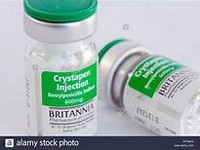Benzylpenicillin
CLINICAL USE
Antibacterial agent
DOSE IN NORMAL RENAL FUNCTION
2.4–14.4 g daily in 4–6 divided doses
PHARMACOKINETICS
DOSE IN RENAL IMPAIRMENT
GFR (mL/MIN)
DOSE IN PATIENTS UNDERGOING RENAL REPLACEMENT THERAPIES
IMPORTANT DRUG INTERACTIONS
Potentially hazardous interactions with other drugsReduced excretion of methotrexate
ADMINISTRATION
Reconstition
Route
IV Bolus, IV Infusion, IM
Rate of Administration
IV bolus: over 3–4 minutes
IV infusion
: over 30–60 minutes
Comments
IV doses in excess of 1.2 g must be given slowly at minimum rate of 300 mg/minute
